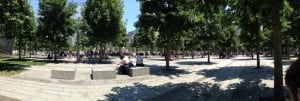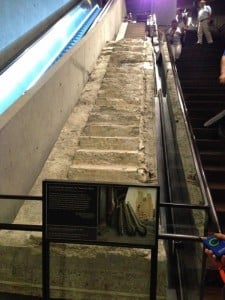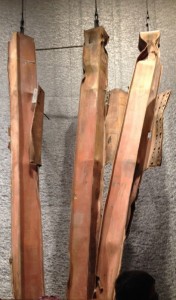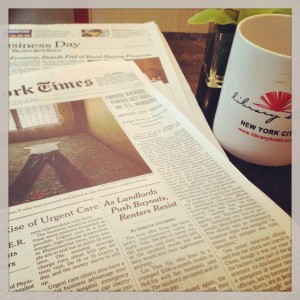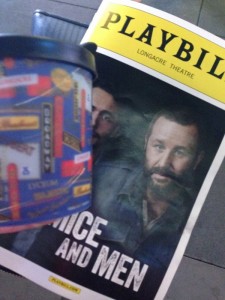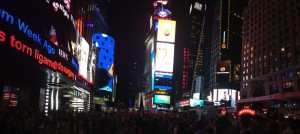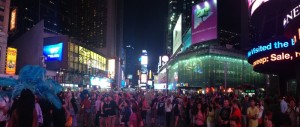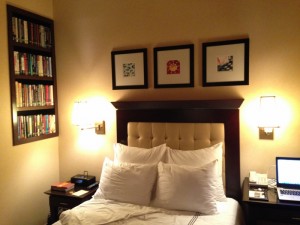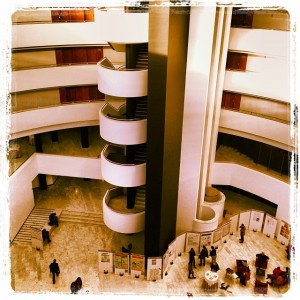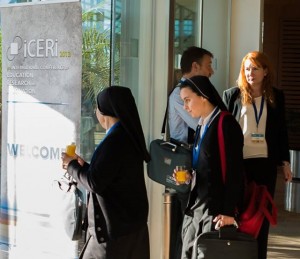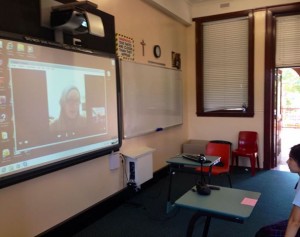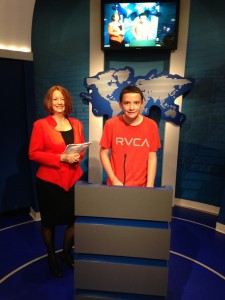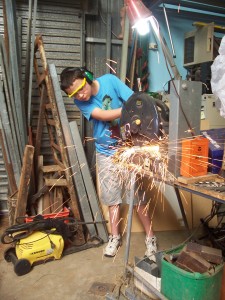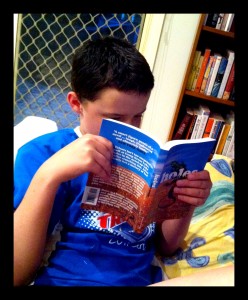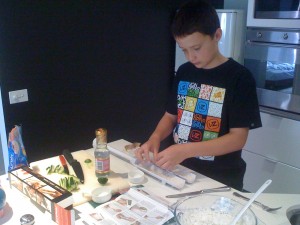Today’s touring started with Grand Central Station which is indeed grand but not as large and cavernous as I thought it would be, damn Hollywood. I then braved the Subway to Downtown. Actually, the happiest, most helpful and friendliest people were on the Subway. For instance, there was a man who wasn’t certain he was on the right train but a couple of different locals generously helped him. He was wearing a navy pinstriped suit with expensive brown leather shoes and a ‘messenger’ manbag. He had short sideburns and a decent layer of stubble. He was going to Wall Street. I think he was going for a job interview.
I alighted at Bowling Green, the stop after Wall Street, at the very southern tip of Manhattan. It was then a short walk to Staten Island Ferry. Thanks to Lonely Planet for this tip because it is FREE. The trip takes half an hour each way and passes by the Statue of Liberty so I didn’t need to accept any of the many hawkers’ offers for a cruise to pay my respects to liberty, particularly since I didn’t have a desire to be up close and personal with the lady.
Of course I then had to walk through the financial district to satisfy my young yuppy heart. However, the New York Stock Exchange was barricaded off with only very-well dressed people entering, so I don’t know if the barricades are permanent or if there was a special occasion. I suspect the former. The tragedy was that there were so many tourists, particularly of the guided tour variety, I didn’t even see the bull (I forgot to look for it too)!
ReflectingAbsence (click for 5s video)
I then made my way to the true site of tragedy, the World Trade Centre Site, also known as the 9/11 Memorial and Museum. The two memorial water features, called ‘Reflecting Absence’, occupy the spaces where the two towers once stood and are an acre in size each. They are truly moving and fitting for the homage they pay to the people lost, whose names are imprinted around the edges. It was a bit odd to see a number of people throw the memorial a glance, pose for a smiling photo, and leave, probably to tick-off the next tourist destination for the album. One young couple I saw from a distance were in an emotional embrace, I think he was comforting her, but they stood out for their sadness.
I had a couple of hours to fill before my appointed tour time so I hopped benches in the Memorial Plaza to follow the shifting shade. I also chatted to anyone who sat next me for a while. I started conversations with “Where are you from?” and soon followed up with “Did you know anyone?”. These are their stories.
- An older couple visiting from Florida. He was wearing a baseball cap that said ‘Cold War Veteran’ (apparently it’s quite a thing – soldiers who weren’t in a physical war during the Cold War want greater recognition – see this WSJ article) and she had a problematic sciatic nerve so needed to rest regularly. They lived in New York City many years ago. When the 9/11 attacks occurred she was visiting friends on 86th street. The night before had been quite a party so they were all sleeping-in when her husband called from Florida. She couldn’t leave due to the airport and other transportation being shut-down. Eventually she took a 27 hour bus journey from the East to West Coast with so many others desperate to leave. The couple didn’t know anyone directly who had died but their daughter-in-law did and a friend in Florida had a son who died. They said it would be hard to find anyone who had ever lived in New York to not be connected to a death from 9/11. She didn’t want to come to the site but he did. On a happier note, they had visited Sydney about 10 years ago. Loved it. One highlight was dining at Doyles. Another was attending a Sydney Theatre production – loved the location, walked out on the play though. They also went to New Zealand and claim the South Island is the prettiest place on Earth.
- Family of five (three generations). A woman in her late 50s or so sat next to me having lost the remainder of her family in the crowds. She was tired and frustrated as she tried to contact them. When her daughter and grandsons (aged 12 and 14yo) arrived they were tired and cranky too. They had all travelled from Long Island that morning, a long bus trip of 1.5 hours in good traffic. They had encountered bad traffic on the 6.30am ride. The daughter and her sons were visiting from Phoenix, Arizona. They hated crowds, and the city in general, not really wanting to go into the 9/11 Museum at all. According to their grandmother, all the boys wanted to do was play arcade games and eat pizza. Sounds like my 14 year old, I said. They knew a few people who died in the 9/11 attacks. The elder woman knew a first responder who had died. The daughter had gone to school with a man who was in the second tower, above the impact line. She was also friends with his wife. He had also been there during the 1993 Bombing and figured he had been fine during that incident, so assured his wife he was going to be fine this time too. The wife was pregnant with their fourth child and the daughter to whom I was speaking was pregnant with her second so they had been travelling that path together. They are no longer on the same life journey. There have been campaigns to raise money for the family left behind and apparently they are financially quite well off as a result… The daughter just shook her head to explain the rest. She is also friends with a first responder, aged in his late 40s, who is now suffering from cancer in the brain, lungs and bones, probably due to the dust and carcinogens of 9/11, and is struggling to meet the financial costs of fighting the cancer. She kept saying, it’s sad, and letting her voice drift off. The Long Island lady said that immediately after 9/11 many families just packed up and left New York City, moving to the Hamptons (a wealthy area of Long Island) with the intention to never return. School numbers swelled as a result. After they left me for their entry time to the museum I wondered how much it was the crowds that made them tense, tired and irritable, and how much it was the memories and connections.
- Homeland Security Woman. My last encounter was with a woman who says she owes her job to 9/11 because Homeland Security only existed after 9/11. Everything I know about Homeland Security I learned from Claire Danes and Damian Lewis in the TV Show Homeland. I didn’t mention that. She lives in Corpus Christi, Texas and was in New York for a wedding the next day. She said she just had to visit the memorial, partly because of her job, partly because she knew people who had been at the Pentagon that day.
It was finally my turn to enter the museum. I went on an hour long tour led by the wonderful Stephanie, who spoke with knowledge, poise and dignity, the entire time. It was mainly a tour of artefacts.
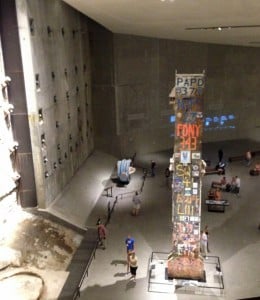 This is called the Last Column. It was so well secured that the rescuers couldn’t remove it so they shifted through the debris all around it and as the debris was removed it became increasingly a makeshift memorial. To the left of the column is a slurry wall that is the original wall holding back the Hudson River. This wall was originally below the point that anyone would see of the tower. The points ‘hammered’ in strengthen the wall (sorry, lack of engineering knowledge being exposed here). There was a concern in the aftermath of the collapse that these walls had also been weakened and not only would the underground of the towers be flooded but also the Subway system. The walls are now reinforced. The main section you see in the photo is a new concrete wall, strengthening the one behind it, but you can also see a small part of a section that has had more points inserted but without a whole new wall built in front of it.
This is called the Last Column. It was so well secured that the rescuers couldn’t remove it so they shifted through the debris all around it and as the debris was removed it became increasingly a makeshift memorial. To the left of the column is a slurry wall that is the original wall holding back the Hudson River. This wall was originally below the point that anyone would see of the tower. The points ‘hammered’ in strengthen the wall (sorry, lack of engineering knowledge being exposed here). There was a concern in the aftermath of the collapse that these walls had also been weakened and not only would the underground of the towers be flooded but also the Subway system. The walls are now reinforced. The main section you see in the photo is a new concrete wall, strengthening the one behind it, but you can also see a small part of a section that has had more points inserted but without a whole new wall built in front of it.
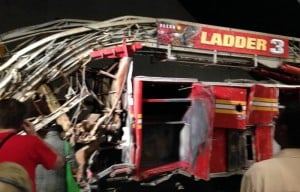 This is the fire engine of Ladder 3. It had 11 firefighters travelling on it the morning of 9/11. All of them died. The truck was later found under the rubble. The left side of the photo shows the remains of the driving cabin. The captain of this crew had a helmet called his lucky helmet because it had saved him from so many dangers. He wasn’t wearing that helmet that day because it was being repaired. His family donated it to the museum.
This is the fire engine of Ladder 3. It had 11 firefighters travelling on it the morning of 9/11. All of them died. The truck was later found under the rubble. The left side of the photo shows the remains of the driving cabin. The captain of this crew had a helmet called his lucky helmet because it had saved him from so many dangers. He wasn’t wearing that helmet that day because it was being repaired. His family donated it to the museum.
Other artefacts included the Survivors Stairs and Steel Beams from the impact zone:
The final part of the memorial I’m going to share with you is an art work in front of the Remains Repository. The NY Office of the Chief Medical Examiner is working through the unidentified remains from 9/11 in the hope of identifying them for the 40% who have yet to be satisfied in this way. The art work is called Trying To Remember the Color of the Sky on That September Morning and (supposedly) consists of 2983 different shades of blue to represent each individual who died at the World Trade Centre, including the six who died in 1993.
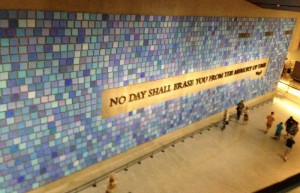 Overall, I thought the Museum was very tasteful and respectful. But then I’m an outsider. Here’s the BBC’s perspective, another outsider really. I was very glad to find the shop was to the side and there was no forcing your way through it in order to exit. I did buy a few gifts but then I have a son who a few years ago was obsessed by 9/11 and researched it extensively. I promised I’d bring him back something from the site.
Overall, I thought the Museum was very tasteful and respectful. But then I’m an outsider. Here’s the BBC’s perspective, another outsider really. I was very glad to find the shop was to the side and there was no forcing your way through it in order to exit. I did buy a few gifts but then I have a son who a few years ago was obsessed by 9/11 and researched it extensively. I promised I’d bring him back something from the site.
I travelled back on the Subway, stopped in opposite the hotel to have my nails done and paid the extra for a shoulder massage. It felt quite a facile activity after the experiences of the day. I then slept for 4 hours in the evening, ate a late dinner and it is now 2.30am local time. Oops. But I had to write all this down while it was fresh. I hope it isn’t too much of a downer.




